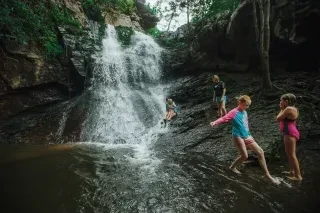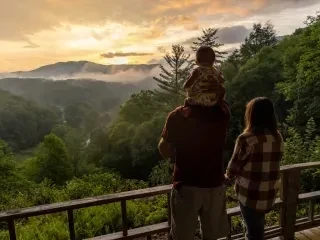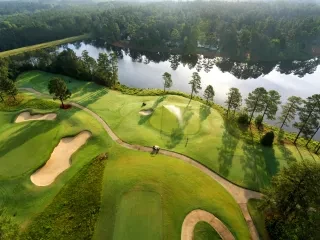
Hero - Interior Page Hero Module
Living cultures, lasting roots
With traditions as broad and deep as North Carolina’s waterways, NC’s first inhabitants created incredibly complex cultures. Museums invite you into the story, while festivals immerse you in an experience you can see, hear, taste and smell.
Native Americans have profoundly impacted North Carolina’s history and culture. They were the original stewards of the lands on which we now live, influencing language, food, art and spirituality. Many Indigenous communities remain here, preserving their identities.
North Carolina is home to eight state-recognized Native American tribes; the Eastern Band of the Cherokee is the only fully federally recognized tribe in the state. The Cherokee’s Kituwah Mound, also known as the Cherokee Mother Town (near present-day Bryson City), is considered the Cherokee’s place of origin. The remaining tribes are the Coharie, Haliwa-Saponi, Meherrin, Sappony, Occaneechi Band of the Saponi Nation, Waccamaw-Siouan and the Lumbee Tribe of North Carolina.
The Lumbee Tribe is the largest tribe in the state and the ninth largest in the nation with more than 55,000 members. (Their name is rooted in the Lumber River, originally known as the Lumbee.) At the request of the Lumbee Tribe, North Carolina established the Croatan Normal Indian School in 1887, the only state-supported school in the country created by and for Native Americans. It’s now the University of North Carolina at Pembroke.
To learn more about the rich heritage of the state’s Indigenous peoples, plan to visit North Carolina’s museums, historical sites and powwows. These places and events tell the story of Native Americans and their customs and serve as a critical reminder of the state’s complex history.
Listicle View
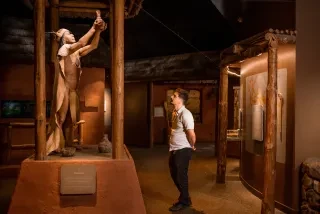
Museum of the Cherokee People
This museum invites you to immerse yourself in the history, culture and stories of its people through collections, events and programs. Bushyhead Condill, a citizen of the Eastern Band of Cherokee Indians, is leading a multiyear renovation and rebrand at the museum, which is one of the longest operating tribal museums in the country. She says it’s becoming “a living, first-voice museum.” Rotating exhibits might dive deep into fashion or current government sovereignty on tribal lands, and the store introduces Indigenous makers through home decor, CBD-infused creams, clothing and an extensive collection of books.
Qualla Arts and Crafts Mutual
Across the street from Museum of the Cherokee People, Qualla Arts and Crafts Mutual is another must-stop for original Cherokee art, wares and jewelry.
Museum of the Southeast American Indian
The permanent Indigenous artifacts include a 1,100-year-old dugout canoe recovered 40 years ago in a nearby river. The museum grounds are also their own piece of history, being located at UNC Pembroke, the only state-supported school in the US created by and for American Indians.
Cherokee County Historical Museum
This museum serves as a center for the Trail of Tears National Historic Trail. Murphy was the site of Fort Butler, one of the main holding areas for Cherokees who were forcibly removed from North Carolina in the 1830s. The museum contains more than 2,000 authentic artifacts of the Cherokee Nation and 40 exhibit panels that interpret its history and culture.
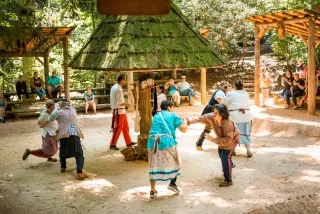
Oconaluftee Indian Village
Weavers make baskets, hunters shoot blowguns and workers hull canoes at this outdoor living history museum, which recreates an 18th-century Cherokee community.
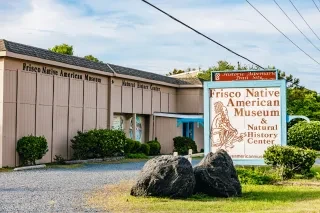
Frisco Native American Museum & Natural History Center
Examine an expansive collection of Indigenous artifacts, including an exhibit dedicated to the original Outer Bankers: Native Roanoac, Hatorask, Croatoan and other barrier island tribes. Annotated trails guide visitors through acres of maritime forest.
Occaneechi Village Replica Site
Serving as a reminder of the tribe’s presence in local history, this site is home to a reconstructed 17th-century village on the banks of the Eno River. The layout is based on excavations of Occaneechi Town, a nearby anthropological site.
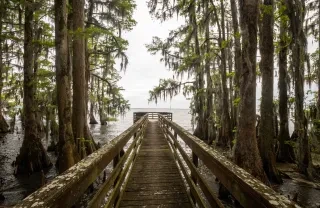
Pettigrew State Park
Native American history here has sparked a National Geographic Society project and vast archaeological research. Through joint work, 30 dugout canoes and hundreds of Indigenous artifacts have been identified in the park’s Lake Phelps, the second-largest natural lake in the state.
Living History Center at Catawba Meadows Park
Walk through a grouping of structures modeled after a 16th-century Catawba Indian village that once stood here.
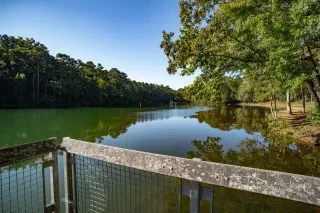
Cliffs of the Neuse State Park
Before colonial contact, the Native Tuscarora and Saponi tribes performed ceremonies here, drawn to the elevation and medicinal plants. Today, the 90-foot-tall bluffs above the Neuse River hold secrets about their ancient past. You might spot seashells or marine fossils in the colorful layers forming the rock face.
Town Creek Indian Mound
Mystery surrounds the Indigenous community that built a large earthen structure rising 15 feet high. Experts believe this marked a political and religious center between 1100 and 1400 A.D. Artifacts on display include materials from as far as the Great Lakes region, indicating impressive trade routes.
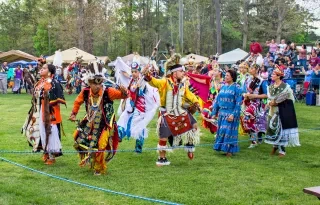
Haliwa-Saponi Indian Tribe Blooming of the Dogwood Powwow
The oldest powwow in North Carolina celebrates state recognition of the tribe in 1965. The powwow’s timing coincides with the annual blooming of the dogwood tree, which, in addition to its medicinal uses, holds significant cultural value for the tribe.
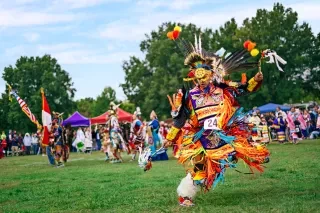
Dix Park Inter-Tribal Pow Wow
Set near downtown Raleigh in Dix Park, this recently established event features a day of dancing, music and vendors, uniting and celebrating all Indigenous tribes in North Carolina. Be sure to taste warm, puffy fry bread from The Cookhouse and Goin’s Kitchen.
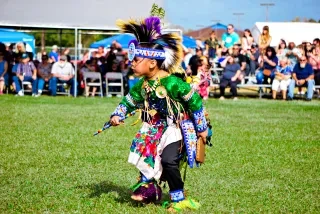
Onslow Veterans Pow Wow
Coinciding with Native American Heritage Month and Veterans Day, the colorful celebration attracts visitors from the largest Marine Corps base on the East Coast, making it a popular event for active-duty military and veterans.
Continue to broaden your cultural and culinary horizons with The Official 2025 North Carolina Travel Guide.
